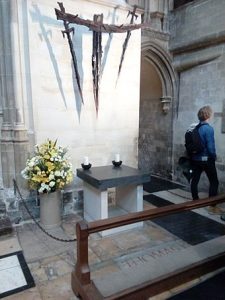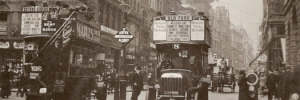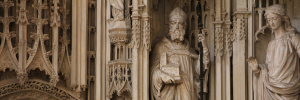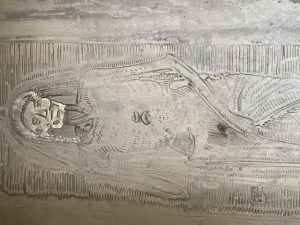Discover the fascinating history of Thomas Beckett and the revival of the Beckett Pageant for London, a celebration of his life and legacy. This blog post explores the origins of the pageant, its connection to the 1519 Midsummer Watch, and its modern-day incarnation. Join us as we delve into the rich history of Thomas Beckett and the traditions that continue to thrive in London.
Thomas Beckett: A Powerful Figure in the 1100s
Thomas Beckett was a prominent figure in the 1100s, serving as royal chancellor and later as archbishop of Canterbury. His influence and power made him a significant figure in medieval England.
Beckett was born in London in 1118. He studied law at the University of Paris before entering the service of Theobald, the archbishop of Canterbury. Beckett quickly rose through the ranks and became Theobald’s most trusted advisor. In 1154, when Henry II became king of England, he appointed Beckett as his chancellor, making him one of the most powerful men in the kingdom.
As royal chancellor, Beckett was responsible for overseeing the royal treasury and managing the king’s finances. He was also involved in the administration of justice and played a key role in the development of the legal system. Beckett’s position gave him significant influence over the affairs of the kingdom, and he used his power to promote the interests of the church.
In 1162, Beckett was appointed as the archbishop of Canterbury, the highest position in the English church. This appointment was met with considerable opposition from the king and other members of the clergy, who saw Beckett’s promotion as a threat to their own power. The conflict between Beckett and Henry II would ultimately lead to Beckett’s assassination in 1170.
Despite his untimely death, Beckett’s legacy as a powerful figure in the 1100s is still remembered today. His determination to defend the rights and independence of the church against the crown made him a symbol of resistance and a martyr for the cause. The events surrounding his life and death were a defining moment in the power struggle between the church and the state in medieval England.
Thomas Beckett’s rise to power as royal chancellor and later as archbishop of Canterbury made him a significant figure in medieval England. His influence and determination to protect the rights of the church against the crown set him apart as a powerful and influential figure in the 1100s.
From Patron Saint to Pageant
Following his assassination, Thomas Beckett became the patron saint of London until 1532. This status inspired the creation of the Beckett Pageant for London, a grand celebration of his birth, martyrdom, and translation.
Thomas Beckett, also known as Saint Thomas of Canterbury, was the Archbishop of Canterbury in the 12th century. He was an influential figure in medieval England and had a close relationship with King Henry II. However, their friendship turned sour when Beckett defended the rights and privileges of the church against the king’s attempts to assert his authority.
In 1170, tensions between Beckett and Henry II reached a breaking point, and four knights, believing they were carrying out the king’s wishes, stormed into Canterbury Cathedral and brutally murdered the archbishop. This shocking event sent shockwaves throughout Europe and led to Beckett’s martyrdom.
Following his death, Beckett quickly became a popular figure of veneration, with rumours of miracles associated with his relics. London, as the capital of England, took particular pride in having Beckett as its patron saint. His patronage brought prestige and religious significance to the city.
1519 Pageant
A historic pageant took place in 1519. This iconic pageant was a part of the Midsummer Watch, an annual summer celebration in London. The 1519 pageant was a grand affair that involved elaborate floats, acted scenes, and captivating characters.
One can only imagine the buzz and excitement surrounding the Midsummer Watch back in the 16th century. The streets of London would have been filled with the sound of music, laughter, and the crowd’s cheers. The pageant would have been a visual spectacle, with stunning floats decorated with vibrant colours, intricate designs, and symbolic representations.
The acted scenes during the pageant would have brought stories to life, transporting the audience to different times and places. Talented performers would have played out historical events or mythical tales, captivating the viewers with their skill and passion. From knights in shining armour to fair maidens, the characters would have been larger than life, evoking a sense of wonder and awe.
Myths and Legends of Thomas Beckett
Thomas Beckett, the iconic figure of English history, has a myth that adds intrigue and romance to his already captivating story. One of the most popular tales involves his father’s love affair with the sultan’s daughter during a crusade.
According to the legend, Thomas Beckett’s father, Gilbert, was a noble knight who participated in the Third Crusade. It was during this holy war that he met and fell in love with the daughter of a powerful sultan. Their forbidden romance became the stuff of legends, as they defied social boundaries and risked everything for their love.
Their love continued to flourish even after the crusade ended, with Gilbert returning to England and the sultan’s daughter remaining in the exotic lands of the East. They kept their love alive through letters and secret rendezvous whenever possible.
Their relationship faced numerous obstacles, including the disapproval of their families and the dangers of a possible war between their respective countries. However, their love persisted, and they vowed to reunite one day and build a life together.
Tragically, their reunion was not meant to be. Gilbert fell in battle, fighting for his cause and for the love he cherished. The news of his death reached the sultan’s daughter, who was devastated by the loss of her beloved.
Thomas Beckett, the product of their forbidden love, grew up hearing stories of his parents’ extraordinary romance. These tales instilled in him a sense of adventure and a longing for a love as powerful as theirs.
As Thomas Beckett became a prominent figure in English history, his myth grew and intertwined with the legends of his parents’ love story. It added an air of mystery and passion to his already esteemed reputation, making him more than just an archbishop, but also a symbol of love and devotion.
The tale of his father’s love affair with the sultan’s daughter during the crusade became a part of Thomas Beckett’s legacy, reminding us that even in the midst of conflict and adversity, love can conquer all.
Thomas Beckett’s Legacy in London

Thomas Beckett, the Archbishop of Canterbury in the 12th century, left an enduring legacy in London that extends far beyond the pageant. His influence can be seen in various aspects of the city, from the hospitals that bear his name to the shrine dedicated to him on London Bridge. But perhaps even more significant is his continued presence in civic ceremonies, reminding Londoners of his lasting impact.
Hospitals named after Thomas Beckett
One of the most tangible ways in which Beckett’s legacy lives on is through the hospitals that bear his name. St Thomas’ Hospital, located near the Houses of Parliament, was founded in the 12th century in honour of the saint. Over the centuries, it has grown to become a leading medical institution, providing exceptional care to the people of London. Similarly, the Beckett Street Hospital in Southwark also pays tribute to the Archbishop, offering essential healthcare services to the local community.
The Shrine on London Bridge
Another visible testament to Thomas Beckett’s enduring legacy is the shrine dedicated to him on London Bridge. The original shrine was destroyed during the Reformation, but its significance was not forgotten. In recent years, a replica of the shrine has been placed on the bridge, serving as a powerful reminder of Beckett’s martyrdom and the devotion he inspired.
Henry VIII’s Target: Defiance and Religion
During the reign of Henry VIII, one man became the target of the king’s fury, Thomas Beckett. Beckett’s representation of defiance against royal authority and the old Catholic religion made him a thorn in Henry’s side. This conflict between church and state ultimately led to Beckett’s martyrdom.
Thomas Beckett was a close friend and adviser of Henry’s father, King Henry VII. When Henry VIII ascended to the throne, he expected Beckett to continue supporting him and his policies. However, Beckett had a strong sense of loyalty to the Catholic Church and its traditions, which frequently put him at odds with the king’s desire for increased royal authority.
Henry VIII, known for his temper and unyielding nature, became increasingly frustrated with Beckett’s defiance. He believed that as the head of the Church of England, he should have complete control over religious matters in his kingdom. Beckett, on the other hand, saw himself as a defender of the church’s independence and an advocate for the old Catholic ways.
The conflict between Henry VIII and Thomas Beckett came to a head when the king issued the Act of Supremacy in 1534, establishing the Church of England as a separate entity from the Catholic Church. This act effectively made the king the head of the church and gave him the authority to make decisions regarding religious doctrine and practices.
Beckett saw the Act of Supremacy as a direct attack on the authority of the Pope and the Catholic Church. He refused to recognise Henry VIII as the head of the church and continued to support the old Catholic traditions. This defiance infuriated the king and led to a series of confrontations between the two.
In 1538, Henry VIII ordered the destruction of Beckett’s shrine at Canterbury Cathedral, an act that symbolised his determination to crush any opposition to his authority. Beckett was then arrested and charged with treason. Despite pleas for mercy, he was found guilty and sentenced to death.
On December 29, 1170, Thomas Beckett was brutally murdered in Canterbury Cathedral by four of Henry VIII’s knights. This act of violence shocked Europe and made Beckett a martyr for the Catholic cause. Henry VIII may have achieved his goal of silencing Beckett’s defiance, but he could not erase the impact of his actions.
The conflict between Henry VIII and Thomas Beckett serves as a stark reminder of the power struggle between church and state during this tumultuous period in history. It highlights the dangers of absolute authority and the lengths some rulers will go to maintain control. Beckett’s martyrdom remains a symbol of resistance against tyranny and a testament to the enduring power of faith.
Find out more about Medieval London on our Medieval Guided Walk
Buy tickets for a guided walk




